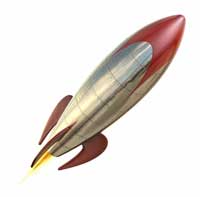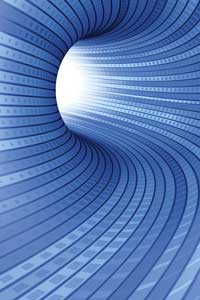Time travel: science fact or science fiction? Understand article
Do you believe that time travel has no place in a serious science lesson? Jim Al-Khalili from the University of Surrey, UK, disagrees. He shows how the topic of time travel introduces some of the ideas behind Einstein’s theories of relativity.

Image courtesy of the University of Surrey
When physicists want to get people excited about their subject, they usually turn to cosmology or particle physics. There is always going to be something exciting to say about space or the search for new particles at the Large Hadron Collider (for a discussion of the LHC, see Landua & Rau, 2008, and Landua, 2008). Of course, it is far more challenging to make electromagnetism or thermodynamics sound exciting.
So is introducing a subject like time travel a little like giving in to science fiction? I would argue not. In fact, I think it is an excellent way of getting across some of the basic ideas behind Einstein’s theories of relativity (yes, there are two of them). One can begin by asking the simple yet emotive question: is time travel really possible? Anyone who has watched a movie such as The Terminator or is a fan of Dr Who may worry that the concept of time travel, while great fun to contemplate, is just nonsense with no place in real science. However, not only do the laws of physics allow for time travel, but it has also been proven possible in many experiments.
Of course I should qualify this bold statement by pointing out that only time travel into the future has actually been achieved. Time travel into the past is much more difficult, and is probably impossible. What is so fascinating, though, is that it cannot be ruled out yet. My aim in this article is to explain the difference between these two directions of time travel and to show how relativity theory forced physicists to abandon common-sense notions about the nature of time itself.
Isaac Newton: the common sense approach?
Until Isaac Newton completed his work on the laws of motion in 1687, the definition of time had been considered to be the domain of philosophy rather than science. However, when Newton described how objects move under the influence of forces, time was an integral part of his mathematical description of reality, since all movement and change require the notion of time to make sense. Newton viewed time as absolute and relentless; he described it as existing entirely outside of space and independent of all processes that occur within space. This is still the view that most of us have: we think of time as flowing at a constant rate, as though there were an imaginary cosmic clock that marks off the seconds, hours and years regardless of our feelings about the passage of time. We have no influence on its rate of flow and cannot make it speed up or slow down. We feel we know what time is – but no one really does. The best definitions we have are rather silly, like saying ‘time is nature’s way of stopping everything happening at once!’ or ‘time flows by at a constant rate of one second every second’. What on earth does that mean anyway?
Was Newton right? Does such absolute time really exist? Albert Einstein showed that it doesn’t.
Albert Einstein: a revolutionary
In 1905, Einstein discovered, through his study of the nature of light, that time and space are not independent but are intimately linked. His ideas became known as the special theory of relativity, which heralded a revolution in physics. It showed how and why the old notions of space and time had to be replaced with a new and unfamiliar set of concepts. Basically, relativity theory unifies time with the three dimensions of space into something called space-time. This is where the idea of time as the fourth dimension comes from.

/ iStockphoto
In 1915, ten years after his work on special relativity, Einstein completed his theory of gravity, known as the general theory of relativity. Widely regarded as the most beautiful scientific theory ever discovered, it describes how the gravitational effects of matter affect space-time. This led to many exciting predictions that were subsequently shown to be correct, such as the birth of the Universe in the Big Bang and the existence of black holes.
But let us return to the topic of special relativity. Einstein showed that for anything (or anyone) travelling at speeds approaching that of light – an impressive three hundred thousand kilometres per second – time literally runs more slowly. The closer to the speed of light that a clock moves, the slower it will tick as seen by observers watching it zoom past. Nowadays, the slowing down of time is confirmed routinely in particle accelerators, such as the CERN facility in Switzerlandw1. Many physics students get a chance to see this effect in the laboratory by observing a certain type of sub-atomic particle called a muon (pronounced ‘mew-on’)w2.
Let us consider a simple example with numbers. A sprinter runs 100 metres in exactly ten seconds, according to the reliable and highly accurate timekeeping of the judges. Had he, however, carried his own very accurate stopwatch along with him, then, due to time slowing down very slightly for him, his watch would show a time of 9.999999999995 seconds. Of course, this is so close to ten seconds that we would never know the difference. However, scientists routinely need to measure times with this sort of accuracy. The difference between the runner’s and the judges’ watches is just five picoseconds; it is such a small time difference because the athlete is moving so much slower than light.
This is actually quite a subtle concept. If people know anything about the theory of relativity, it tends to be its insistence that all motion is relative. So why is it the sprinter’s watch that runs slower, hence recording the shorter time? If all motion is relative, then we should be able to argue that it is in fact the track that is moving relative to the sprinter. So it should be the judges’ trackside watches that run slower. This is true, but in reality the situation is not completely symmetrical. For one thing, the sprinter has to accelerate and decelerate and this change in speed affects the rate at which his time goes by, relative to that of the judges. Another way of understanding why the sprinter’s stopwatch reads a faster time is that, for him, the distance he has to run is in fact slightly less than 100 metres. This is another consequence of the theory of relativity: that distances are shortened when you move very fast.
High-speed motion: time travel to the future

/ iStockphoto
As this is beginning to sound somewhat strange, we might as well explore how it all links up with time travel. The idea of time slowing down gives us, quite literally, a means of time travel into the future. If you were to travel around our galaxy in a rocket, at close to the speed of light for, say, four years, you would get quite a shock when you returned home to Earth. If your onboard calendar said you left in January 2005 and returned in January 2009, then depending on your exact speed and how twisted your path was through the stars, you might find that on Earth, the year was 2045 and everyone had aged 40 years! They would be equally shocked to see how young you still looked considering how long you had, according to them, been away.
Inside the rocket, four years would have elapsed while Earth-bound clocks counted off 40 years. This means that you would have, for all intents and purposes, leapt 36 years into the future.
This effect has been checked and confirmed many times in different experiments to extremely high degrees of accuracy. In 1971, J. C. Hafele and Richard E. Keating placed four highly accurate atomic clocks on a jet aircraft and flew them eastwards around Earth. After the jet returned, the onboard clocks were compared with reference atomic clocks at the US Naval Observatory: the travelling clocks were a tiny fraction of a second behind the reference clocks (Hafele & Keating, 1972a, 1972b)w3. Even though the jet had a ground speed of up to a thousand kilometres per hour, the speed of light is a further million times greater than this, hence the very small and rather unimpressive difference between the two groups of clocks. Nevertheless, that difference is real and the clocks are so accurate that we do not doubt their readings or the conclusions we draw from them.
Time travel to the past?
Time travel to the past, it turns out, is much more difficult. To many people, it might come as a surprise that travelling forward in time is easier than travelling backward. If anything, you might think that the notion of travelling into the future is the more ridiculous. The past may well be inaccessible, but at least it is out there in some sense: it has happened. The future on the other hand, has yet to happen. How can we visit a time that has not yet happened? However, time travel to the future by high-speed motion does not require the future to be already ‘out there’ waiting for us. What it means is that we move out of everyone else’s time frame and into one in which time moves more slowly. While we are in this state, time outside ticks by more quickly and the future unfolds at high speed. When we rejoin our original time frame, we will have reached the future more quickly than everyone else.
On the other hand, there are many mind-boggling examples of how ridiculous things would be if time travel to the past were possible. For example, what if you were to go back in time, to last year for example, and kill your younger self. What would happen then? Would you simply pop out of existence as the younger you slumps to the ground? And if you died last year, who would have killed you? I know this is a bit morbid, but it is a well-known paradox. Think about it. It seems you cannot kill your younger self because you must survive the assassination attempt to become the assassin. The thing to remember about time travel to the past is that you are allowed to meddle with history as long as things still turn out the way they do. You cannot change the past.

/ iStockphoto
In principle, there would be two ways of going back to the past. One is by going backwards through time, during which the hands of your watch would move anticlockwise. This would require faster-than-light speeds which relativity theory tells us are impossible, and so is not the sort of time travel I am discussing here. The other way is by travelling what appears to you to be forward in time (your watch runs forwards) but by moving along a warped path through space-time that takes you back to your past (like looping the loop on a roller coaster). Such a loop is known in physics as a closed time-like curve and has been the subject of intense theoretical research during the past decade. Perhaps surprisingly, it has been known for half a century that Einstein’s equations of general relativity allow such closed time-like curves: the American mathematician Kurt Gödel showed in 1949 that this type of time travel into the past was theoretically possible.
So what is all the fuss about? Time travel to the future has been done and time travel to the past, while difficult, has not been ruled out by theory. What are we waiting for? Why haven’t we built a time machine yet? The problem is that, apart from the fact that closed time-like curves in space-time are exceedingly difficult to create, we do not really understand them theoretically. As things stand at the beginning of the 21st century, general relativity tells us that we cannot rule out time travel, but many physicists are hoping that a better understanding of the mathematics involved will eventually lead to the conclusion that time loops are impossible.
At the moment, we cannot rule out the possibility that a naturally occurring time machine exists somewhere in the Universe. It is theoretically possible for space-time to be so warped in the presence of a very strong gravitational field that, under certain special conditions, a time loop is created. If we stumbled across such an entity, known as a wormhole, during future space travel it might provide us with a permanent link to the past.
For now, the best way to rule out the existence of time loops is to ask where all the time travellers from the future are. If future generations ever succeeded in building a time machine then surely there would be many people wanting to visit the 21st century and we should see these visitors among us today. So just to keep the debate alive, below are five possible reasons why we should not expect to see any time travellers:
- Time travel to the past is forbidden by some as-yet-undiscovered laws of physics. Physicists hope to discover a new theory that goes beyond general relativity and which explains why time loops are forbidden. We already have two possible candidates for such a theory, known as superstring theory and membrane theory. But neither is properly understood yet.
- There are no naturally occurring time machines, such as wormholes, so the only way to travel back in time is to build one. But it turns out that this would only take us as far back as the moment it was switched on (because that would be the earliest moment in time that could be accessed). So we cannot see any time travellers from the future because time machines have not been invented yet.
- Naturally occurring time machines exist and people do use them to travel back to the 21st century, but – an idea taken seriously by many theoretical physicists – our universe is just one of an infinite number of parallel universes. Thus time travel to the past slides the traveller into a parallel world. There are so many of these that our universe is just not one of the lucky few that have been visited. If you are not convinced by these reasons, then I might interest you in a couple of more mundane possibilities:
- Expecting to see time travellers among us presupposes that they would want to visit this century. Maybe for them, there are much nicer and safer periods to visit.
- Time travellers from the future are among us but they keep a low profile!
If I were a betting man I would say that time travel to the past will soon be shown to be impossible even in theory. Getting to the future, on the other hand, just requires us to build a fast enough rocket. Beware, though, that if you reach the future, there is no coming back.
References
- Hafele JC, Keating RE (1972a) Around-the-world atomic clocks: predicted relativistic time gains. Science 177(4044): 166-167. doi: 10.1126/science.177.4044.166
- Hafele JC, Keating RE (1972b) Around-the-world atomic clocks: observed relativistic time gains. Science 177(4044): 168-170. doi: 10.1126/science.177.4044.168
- Landua R (2008) The LHC: a look inside. Science in School 10: 34-45.
Web References
- w1 – For more information about CERN, the world’s largest particle physics laboratory, see: www.cern.ch
- w2 – For more information about the muon lifetime experiments, see:
- w3 – For more information about the Hafele-Keating experiment, see: http://en.wikipedia.org/wiki/Hafele-Keating_experiment
Resources
On relativity and time travel
Al-Khalili J (1999) BlackHoles, Wormholes and Time Machines. London, UK: Taylor and Francis
On time travel
Davies P (2002) How to Build a Time Machine. London, UK: Penguin
On relativity
Epstein LC (1981) Relativity Visualised. San Francisco, CA, USA: Insight Press Mermin ND (1989) Space and Time in Special Relativity. Prospect Heights, IL, USA: Waveland Press
Stannard R (1989) The Time and Space of Uncle Albert. London, UK: Faber and Faber
On string theory
Greene B (2000) The Elegant Universe: Superstrings, Hidden Dimensions and the Quest for the Ultimate Theory. New York, NY, USA: Vintage
Review
What do we know about time travel? Is it possible to travel to the future,or to the past? To what extent has it been tested, and what were the results? This article gives short but very exciting answers to these questions.
The article is very useful to introduce relativity and associated topics of modern physics to the students. Teachers can use it to discuss issues such as the nature of time and its meaning, or the exciting topic of time travel. It allows for a combination of physics with philosophy.
Taking the article as a starting point, teachers can then discuss further problems of time travel, such as the difficulty of accelerating a 70 kg human to the speed of light.
Alessandro Iscra, Italy





